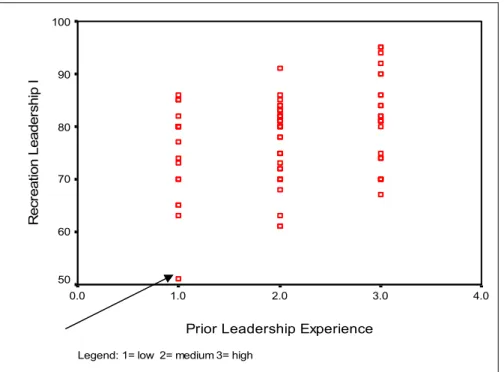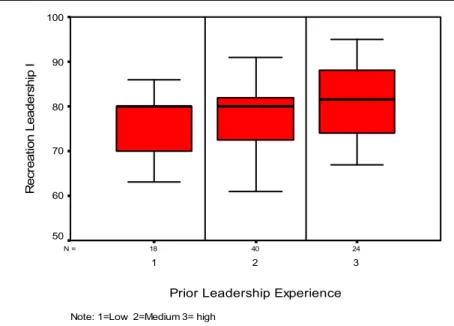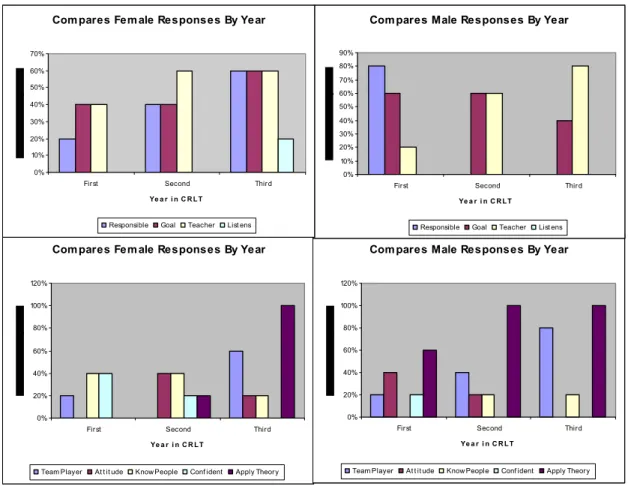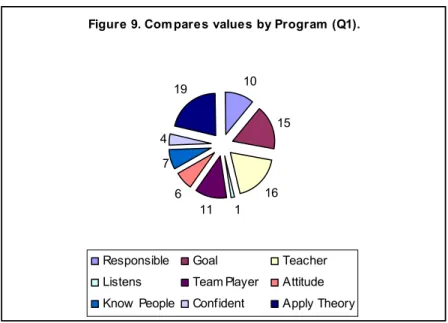UNIVERSITÉ DE SHERBROOKE
Apprendre à être un Leader dans un Programme de Leadership: Perceptions, Éxpérience Préalable en Leadership et Sexe de l’Étudiant
Learning to Lead in a Leadership Program: Perceptions, Prior Leadership Experience, and Gender
par Toni Taylor
Essai présenté à la Faculté d’éducation En vue de l’obtention du grade de
Maître en éducation (M.Éd.) Maîtrise en enseignement au collégial
June 2010 © Toni Taylor, 2010
Apprendre à être un Leader dans un Programme de Leadership: Perceptions, Éxpérience Préalable en Leadership et Sexe de l’Étudiant
Learning to Lead in a Leadership Program: Perceptions, Prior Leadership Experience, and Gender
Silke Lach Ann Beer
LEARNING TO LEAD IN A LEADERSHIP PROGRAM:
PERCEPTIONS, PRIOR LEADERSHIP EXPERIENCE, AND GENDER
SUMMARY
F p
r p
TABLE OF CONTENTS
CHAPTER ONE: STATEMENT OF PROBLEM ... 17
CHAPTER TWO: LITERATURE REVIEW... 23
CHAPTER FOUR: PRESENTATION OF DATA... 51
CHAPTER FIVE: PRESENTATION OF FINDINGS: ... 61
BIBLIOGRAPHICAL REFERENCES APPENDIXA APPENDIXB APPENDIXC - APPENDIXD - APPENDIXE- APPENDIXF -APPENDIXG
APPRENDRE À ÊTRE UN LEADER DANS UN PROGRAMME DE LEADERSHIP :
PERCEPTIONS, ÉXPÉRIENCE PRÉALABLE EN LEADERSHIP ET SEXE DE L’ÉTUDIANT
SOMMAIRE
Community Recreation and Leadership Training CRLT,)
Community Recreation and Leadership Training (CRLT)
Student Leadership Practice Inventory (SLPI)
p < .05.
F p
Recreation Leadership I
r p
CHAPTER ONE
STATEMENT OF PROBLEM 1.1 INTRODUCTION
CHAPTER TWO LITERATURE REVIEW
2.1 What is Leadership?
Social Intelligence
2.4 Leadership Development for College Leaders
The Leadership Challenge
The Five Practices of Exemplary Student Leadership,
CHAPTER THREE METHODOLOGY
3.1 WRITTEN PERSONAL STATEMENTS
3.1.1 Sources of Data
3.2 ADMINISTRATION OF SLPI, PRIOR LEADERSHIP EXPERIENCE, AND ACADEMICS
3.2.2 Description of the Participants in Quantitative Phase of the Study
SD
3.2.3 Selection of SLPI
The Leadership Challenge
3.2.4 Reliability of SLPI
Student Leadership Practice Inventory Facilitators Guide
r = Facilitator’s
3.2.5 Pretest
3.2.8 Variables Used in the Second Phase of the Study
3.3 FOCUS GROUPS
3.3.1 Sources of Data
3.3.2 Description of Participants in the Focus Groups
3.4 Informed Consent
CHAPTER FOUR PRESENTATION OF DATA
SLPI, PRIOR LEADERSHIP EXPERIENCE, ACADEMICS, AND GENDER DIFFERENCES
Table 1
Summary of Participant Characteristics Surveyed
Participants (N = 84) Surveyed in the Study
Year N % Min Max M SD
Females
Males
4.1 Comparison of SLPI by Year
p < .05.
Table 2
Analysis of Variance for Perceptions of Leadership by Term of Enrolment SLPI
Dimensions Enrolment Term N M SD F Sig df
4.2 Sex and SLPI
t
t
Table 3
Independent Sample T Test for Perceptions of Leadership by Gender
Females Males
SLPI
Dimensions N M SD N M SD Diff Df t Sig
32 52 32 52 32 52 32 52 32 52 N = GENDER M F Mean +- 2 SD 5.5 5.0 4.5 4.0 3.5 3.0 2.5 2.0 1.5 SLPI 5 Practices MODEL INSPIRE CHALLENGE ENABLE ENCOURAGE
Figure 1. Error bars for the mean differences on five dimensions for each gender.
4.3 Prior Leadership Experience and Grades
Legend: 1= low 2= medium 3= high
Prior Leadership Experience
4.0 3.0 2.0 1.0 0.0 R ec re at ion Leader shi p I 100 90 80 70 60 50
Figure 2. Showing mean differences and standard deviations for three levels of prior leadership experience
F p
Table 4
Analysis of Variance for Prior Leadership Experience and Grades in the Recreation Leadership I Course in Term I
PRIOR LEADERSHIP EXPERIENCE N M SD F Sig df 24 40 18 N =
Note: 1=Low 2=Medium 3= high
Prior Leadership Experience
3 2 1 R ecr eat ion Lead er sh ip I 100 90 80 70 60 50
Figure 3. Showing mean differences and standard deviations of grades by prior leadership experience.
r p
Leadership Experience and Grades
81.4 76.4 77.7 70 75 80 85
low = 1 medium = 2 high = 3
Prior Leadership Experience
Recre at io n Lead ersh ip I G rad e Aver ag es
Figure 5. Scatterplot showing grades and leadership. 4.4 SLPI and Academic Performance
Levels of Prior Leadership Experience
4.0 3.0 2.0 1.0 0.0 R ecr ea tion Le ad er sh ip I G rad es 100 90 80 70 60
Table 5
Correlations among the Five SLPI Scales and Academic Performances (N=82) Academic
Performance Correlations And Sig Model Inspire Challenge Enable Encourage
CHAPTER FIVE
PRESENTATION OF FINDINGS:
PERSONAL STATEMENTS AND FOCUS GROUPS
5.1.2 Goal Oriented - Code 2
5.1.4 Listens - Code 4
5.1.5 Team Player - Code 5
5.1.7 Know People - Code 7
5.1.9 Apply Theory - Code 9
Table 6
Coding Manual What Does Being an Effective Leader Mean to You? Responders (N = 29)
Table 7
Summary of Personal Statements by Females and Males Prior to Entry Spring 2006 ( N = 29: F = Females: N = 21; M = Males: N = 8)
Codes
1 2 3 4 5 6 7 8
Resp Goal Teach Listen Team Attitu People Confid
F M
5.2 FOCUS GROUPS - YEAR ONE Introduction
Table 8
Q1 How Do You Define Leadership? Comparison of Responses to Q1 by First Year Male and Female Focus Groups, Term II, Winter 2007(F = Females:
N = 5; M=Males: N = 5)
Codes
1 2 3 4 5 6 7 8 9
Table 9
Comparison of Gender Responses To Q1 by Pre-CRLT Program Spring 2006 (S06) to First Year, Term II, Winter 2007 (W07) (F = Females; M = Males;
Percentages are based on the number of actual responders in that code).
Codes
1 2 3 4 5 6 7 8 9
Resp Goal Teach Listen Team Attitu People Confi Apply
(N = 21 (N = 5) (N = 8) (N = 5)
Q3 What do you think is the single most important quality of being an effective leader?
Table 10
Comparison of Focus Group Responses to Q3 by Males and Females, First Year, Term II, Winter 2007 (F = Females: N = 5; M = Males: N = 5)
Codes
1 2 3 4 5 6 7 8 9
Resp Goal Teach Listen Team Attitu People Confid Apply
F M
Q6 Do you feel like you have gained some leadership qualities since you started our Program? Can you say something about this?
Q7 Can you comment on how the program has helped you develop leadership skills?
5.3 FOCUS GROUPS - YEAR TWO Q1 How do you define leadership?
Table 11
Comparison of Responses to Q1 by Male and Female Focus Groups, Second Year, Term 1V, Winter 2007 (F = Females: N = 5; M=Males: N = 5) Code
1 2 3 4 5 6 7 8 9
Resp Goal Teach Listen Team Attitu People Confid Apply
F M
Q3 What do you think is the single most important quality of being an effective leader?
Table 12
Comparison of Second Year Responses (Q3) by Gender F = Females: N = 5; M
= Males: N = 5)
Code
1 2 3 4 5 6 7 8 9
Resp Goal Teach Listen Team Attitu People Confid Apply
F M
Q6 Do you feel like you have gained some leadership qualities since you started our Program? Can you say something about this?
Q7 Can you comment on how the Program has helped you develop leadership skills?
5.4 FOCUS GROUPS - YEAR THREE
.
Q1 How do you define leadership?
Table 13
Comparison of Responses to Q1 by Male and Female Focus Groups, Third Year, Term VI, Winter 2007(F = Females: N = 5; M=Males: N = 5)
Code
1 2 3 4 5 6 7 8 9
Resp Goal Teach Listen Team Attitu People Confid Apply
F M
Table 14
Summary Comparison of Q1 by Gender Pre CRLT: Females ( N = 21) Males ( N
= 8) Females N = 36 Males (N =23 Code Resp Goal Teach Listen Team Attitu Peop Confid Apply ( N =5)
Figure 6. Summary comparison of the amount of female and male responses by year.
Compares Female Responses By Year
0% 20% 40% 60% 80% 100% 120%
First Second Third
Ye a r i n CR LT
Team Player At t it ude Know People Conf ident Apply Theory
Compares Male Responses By Year
0% 20% 40% 60% 80% 100% 120%
First Second Third
Ye a r i n C RLT
Team Player At t it ude Know People Conf ident Apply Theory
Compares Male Responses By Year
0% 10% 20% 30% 40% 50% 60% 70% 80% 90%
First Second Third
Ye a r i n C RLT
Responsible Goal Teacher List ens Compares Female Responses By Year
0% 10% 20% 30% 40% 50% 60% 70%
First Second Third
Ye a r i n C RLT
Table 15
Summary of Total Responses by Gender and Comparison of Responses by Year
Total Responses: N=59; Pre CRLT Personal Statements: N = 29; Focus Group Q1: N = 30; 1st Yr: N = 10; 2nd Yr: N = 10; 3rd Yr: N = 10)
Number of
Responders Percentages of Responses
Total
Response % of Total Response CODES Pre CRLT 1st Yr 2nd Yr 3rd Yr % Pre CRLT % 1st Yr % 2nd Yr % 3rd Yr Response Goal Teacher Listens Team Player Attitude Know People Confident Apply Theory
Figure 9. Compares values by Program (Q1). 10 15 16 1 11 6 7 4 19
Responsible Goal Teacher Listens Team Player Attitude Know People Confident Apply Theory
Q3 What do you think is the single most important quality of being an effective leader?
Table 16
Comparison of Third Year Responders Across Codes by Gender (Q3).
F = Females: N = 5; M = Males: N = 5)
Code
1 2 3 4 5 6 7 8 9
Table 17
Summary of Male and Female Focus Groups’ Responses for Q3 (F = Females: N =
15; M = Males: M = 15)
Q3. What do you think is the single most important quality of an effective leader?
1 2 3 4 5 6 7 8 9
GEN
TOT Code Resp Goal Teach Listen Team Player Attitude People Know Confi-dent Theory Apply F
M F/M TOT
Q6 Do you feel like you have gained some leadership qualities since you started our Program? Can you say something about this?
Q7 Can you comment on how the Program has helped you develop your leadership skills?
CHAPTER SIX
DISCUSSION AND CONCLUSION
6.1 RESEARCH QUESTIONS
6.1.1 How do perceptions of leadership change as a result of being in a three-year leadership program?
Prior to entry: First year Second year Third year
6.1.3 Does prior leadership experience result in better academic performance for CRLT students in their first term?
F p
r p
6.1.4 Is there a correlation between students’ first semester grades and their scores on the Student Leadership Practice Inventory (SLPI)?
BIBLIOGRAPHICAL REFERENCES
Management Decision, 43
Journal of Physical Education, Recreation & Dance, 72
Encyclopedia of human behavior 4,
Encyclopedia of mental health
Journal of the Indiana University Student Personnel Association, .
How to observe your group
Journal of Physical Education, Recreation, and Dance, 74
Emotional Intelligence, Social Intelligence,
Education in Quebec
The leadership challenge
The five practices of exemplary student leadership
College Student Affairs Journal, 19
APPENDIX A
Appendix A
COMMUNITY RECREATION LEADERSHIP TRAINING PERSONAL STATEMENT
What does being an effective leader mean to you?
This information is confidential. However, this information may be used for statistical purposes in order to improve the success of students in our program.
APPENDIX B
Appendix B
* Please complete this form and bring it with you to the interview. COMMUNITY RECREATION LEADERSHIP TRAINING
APPENDIX C
APPENDIX D
Q3, WHAT DO YOU THINK IS THE SINGLE MOST IMPORTANT QUALITY OF AN EFFECTIVE LEADER AND WHY?
Appendix D
Q3 What do you think is the single most important quality of an effective leader and why?
1st Year
Females Responses and [code #]
1
professional attitude-towards his job; 'he knows what is the right time to do the right thing' [3]and ability of observation. 'He knows his people'. [7]added when asked to qualify professionalism- 'love his job and love to talk and communicate with people' [8]. You feel comfortable with him.(later added-"If you are a good listener you are approachable 'cuz people like to come to you".)
2 ‘good listener’ [4]I think is the most important thing –to be a to listen to your group or the person (she qualified later that you learn about the person 3 ‘approachable’. (indicated it was the same as #5)[3]
4 confidence’[8]. Because somebody who is extremely timid or anything won’t be as approachable as someone who is ‘outgoing’ and taker, takes risks and
5
‘approachable’ because a leader, a leader obviously has a lot of stuff on their plate and they know either a lot more they're more knowledgeable than the their peers under them, I don’t really mean under them but they're a leader for a reason-and if someone in the group needed 'help' or something or had a question than that person would have to be approachable so that they could go ask them or even in a group setting they weren’t too overpowering type thing.so that they're all on the same level but they still have that upper hand [3]
1st Year
Males Reponses and [code #]
6 respect from his peers’[3]
7 confidence'-If you don’t feel confident with-with yourself how could people you trying to lead feel confident ...patience(added during discussion)[8] 8 he has to respect his peers[5]
9
cool under fire...that kind of attitude whenever something goes wrong you can’t start panicking…looks to you for you know…exactly guidance (another person filled in the word and 9M agreed and he added-). …'You have to be a rock'.[8]
10
to persuade the people (clarified and 10M agreed it meant having
'influence'[6]/..stood his ground (coach), (had hard time expressing what it was his coach did that taught him so much.)
APPENDIX E
Appendix E
QUESTIONS FOR STUDENT FOCUS GROUPS
These are meant to be open-ended questions whose wording and order may be modified during the meeting
APPENDIX F
SAMPLE TRANSCRIPT OF FOCUS GROUPS (FIRST YEAR MALES Q6)
Appendix F
Year 1 Male Focus Group Transcript:
(Q. 6) - Do you feel that you have gained some leadership qualities since you started the Program? Can you say something about this?
APPENDIX G
SAMPLE ANALYSIS OF A FOCUS GROUP QUESTION (YEAR TWO FEMALES Q6)
Appendix G
Q6 Do you feel like you have gained some leadership qualities since you started our Program? Can you say something about this?
Yr 2 F Codes Explanation
Confidence
Confidence and Listens
“I will say more with my heart what the other person feels”
Communica-tion,
Confidence, and Apply Theory
she can tell people how she feels about what they’re doing
Confidence Apply Theory
the size of CRLT, the community and what she had learned in classes
, “program planning” and “ running meetings
Apply Theory
minute (taking) the running of





